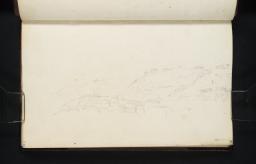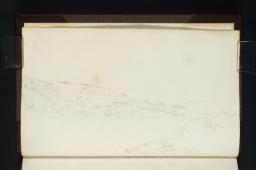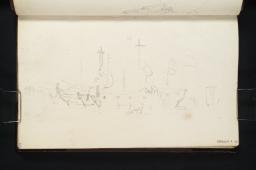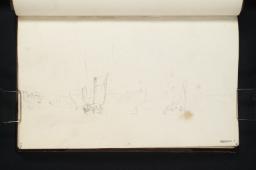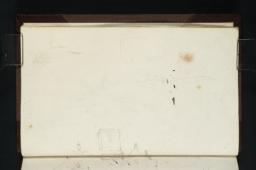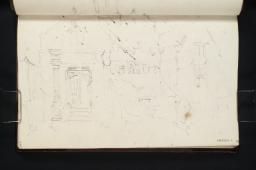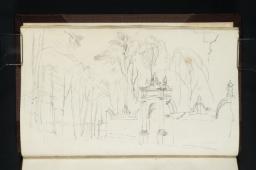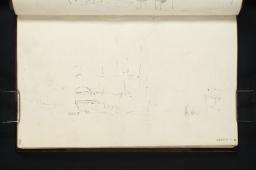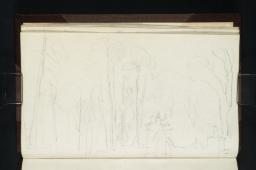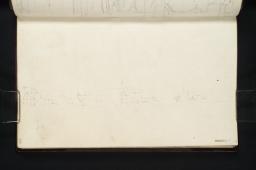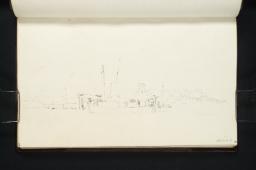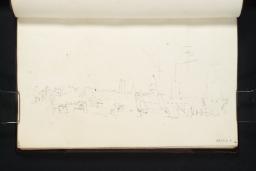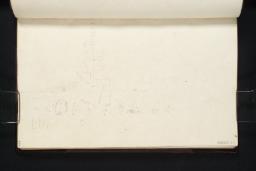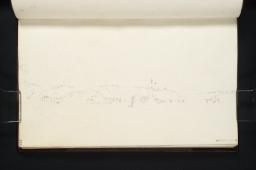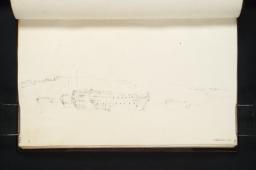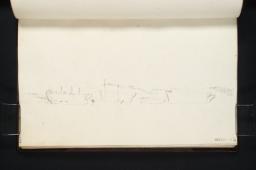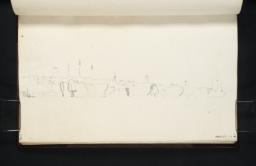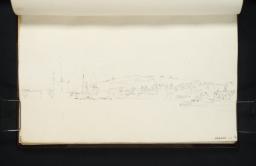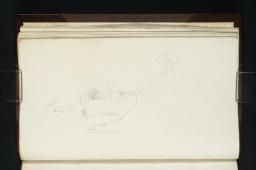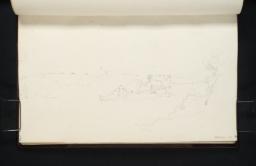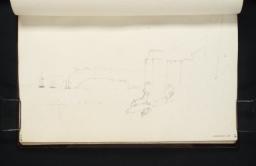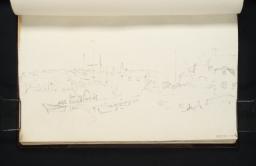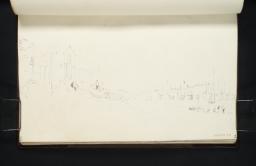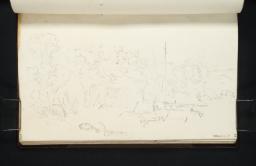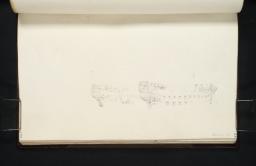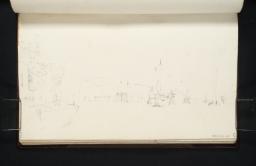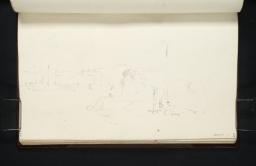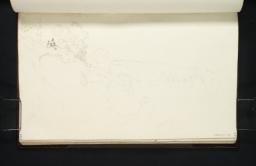Turner Bequest CXXXIII 1–83a
Sketchbook bound in boards, half-bound in modern dark brown cloth with dark brown leather spine and corners blind-tooled along edges adjacent to cloth
86 leaves of white wove paper (three largely torn out and made good with modern paper), between modern pastedowns at front and back, page size 178 x 110 mm
Made by John Fellows at Eynsford Mill, Kent; various pages watermarked ‘Fellows | 1812’
Schedule number 294 and endorsement by the Executors of the Turner Bequest no longer evident (see main catalogue entry); front pastedown inscribed in pencil ‘cxxxiii’ top left
86 leaves of white wove paper (three largely torn out and made good with modern paper), between modern pastedowns at front and back, page size 178 x 110 mm
Made by John Fellows at Eynsford Mill, Kent; various pages watermarked ‘Fellows | 1812’
Schedule number 294 and endorsement by the Executors of the Turner Bequest no longer evident (see main catalogue entry); front pastedown inscribed in pencil ‘cxxxiii’ top left
Accepted by the nation as part of the Turner Bequest 1856
References
This sketchbook mainly comprises drawings made in the summer of 1814 at sites in the south of Devon,1 together with a smaller number of studies made in Yorkshire, as discussed below. In its Devon subjects it complements the contemporary Devon Rivers, No.1 sketchbook (Tate; Turner Bequest CXXXII), which includes subjects in north-west Devon, the west of the county edging into Cornwall, and the Tamar Valley southwards towards Plymouth. The relatively large Devonshire Rivers, No.3, and Wharfedale sketchbook (Tate; Turner Bequest CXXXIV) was used selectively alongside the first two books for more detailed views of the same places (as well as for Yorkshire drawings, probably made in 1816). The first and third books still bear titles and numbers inscribed by Turner on their covers, while the covers of the present book, which Finberg called ‘Devon Rivers, No.2’ were apparently lost before 1909 along with any labels or inscriptions (see the Technical notes below); it is unclear whether he named it on any documentary authority or simply by assuming (correctly, it seems) that it completed the sequence of three.
Having first passed through Plymouth in 1811 on his clockwise journey round the coast of the West Country (see the Introduction to that tour in the present catalogue), Turner had made many drawings in the area on his extended 1813 visit (again, see the relevant Introduction), using the Plymouth, Hamoaze sketchbook (Tate; Turner Bequest CXXXI). Even so, as well as a few sketches of Plymouth Sound (see under folio 2 recto; D09669), the first half of the present book largely comprises yet more studies, mainly on and around the rivers to the west and east of the town.
There are numerous studies on the Hamoaze (the Tamar Estuary), off Plymouth Dock (later Devonport), in places crowded with the hulks of decommissioned, dismasted warships at this late stage of the Napoleonic Wars; see under folio 3 recto (D09671). Among these are several views of Saltash, on the opposite bank; see under folio 26 recto (D09698). There are also studies on the St German’s or Lynher River, which joins the Tamar south of Saltash, showing nearby Trematon Castle and Wearde Quay; see under folio 27 verso (D09700). A resident near Trematon Castle, Mr Charles Nodder, has used his local knowledge of the area to write a privately circulated article discussing the relevant drawings in this sketchbook, after inspecting and discussing them with the present author,2 who is very grateful for his comments, as noted in individual entries. There is also an inscription about bridges on the Tamar on folio 51 verso (D09732).
As Turner left the Plymouth area and travelled north-east, eventually to depart from the county for home, there is a sequence showing the Plym Estuary (the Laira) near Saltram (see under folio 39 recto; D09715), nearby Plympton (see under folio 42 recto; D09718), Ivybridge (see under folio 45 recto; D09722), and Totnes and the River Dart (see under folio 48 verso (D09726). He then drew around Dartmouth and Kingswear, at the mouth of the Dart Estuary (see under folio 50 recto; D09730); these drawings, along with those along the Dart on adjacent pages, are central to Sam Smiles’s proposal that the sketchbook was used in Devon in 1814, as Turner described a recent trip down the river from Totnes to Dartmouth (see under folio 50 recto; D09730) in a letter datable to the autumn of that year3 (see also the overall Introduction to the tour).
There are a distant view of Torbay and a study near Ashburton on folio 49 verso (D09729) as Turner went back inland, further up the Dart Valley to the Buckfastleigh area (see folio 63 recto; D09750), before travelling through the countryside to the north-east (see folios 64 verso and 65 recto; D09753, D09754) towards Exeter; see folio 65 verso (D09755). From there he travelled north up the Exe Valley (see folios 66 verso–69 recto; D09757–D09762) to Bickleigh (see folio 71 recto; D09764) and then Tiverton (see folio 73 verso; D09768), from where he probably returned directly to London, as set out in the proposed itinerary in the overall Introduction.
The Yorkshire drawings in this sketchbook, among others, have been variously associated with Turner’s visits to his friend and major patron Walter Fawkes (1769–1825) at Farnley Hall, in the North Yorkshire Dales north-west of Leeds, ‘from about 1812’4 or ‘between 1811 and 1814’; the extended stays at this period ‘all took place quite late in the year, in November and December’.5 Presumably aware of a number of blank pages remaining after the Devon tour, Turner took the book north with him and used it for a few Yorkshire subjects near the beginning, and rather more at the other end. At various times David Hill dated this material to 1814 or earlier6 (see also under folio 5 recto; D09674), or unequivocally to 18147 (see also under folio 74 verso; D09770). Subsequently he and Karen Lynch noted that it was datable ‘to 1816 or earlier’8 (see also under folio 78 recto; D09777). In his Introduction to the section of this catalogue concerned more widely with Turner’s work at and around Farnley Hall on his many visits between about 1808 and 1824, Hill mentions the Yorkshire subjects in this book as datable to about 1816, along with much other Yorkshire material from the summer of that year which is dealt with as a discrete tour.9
Given that stone architectural features of Newall Old Hill shown in situ there in the present book (see D09674) were supposedly moved to Farnley in 1814, and that the Flower Garden gateway shown at Farnley (see folios 5 verso and 6 verso; D09675, D09677) is recorded as having been moved there in the same year, this suggests the likelihood of Turner’s using this sketchbook there in that year, at a point between these two phases of building operations. Several diagrammatic studies of elaborate wood panelling towards the end of the sketchbook relate to the rough sketch of the interior of the Oak Room in the old part of Farnley Hall on folio 74 verso (D09770) and, as discussed in that entry, may actually have been part of a design process for ongoing changes at Farnley. There are miscellaneous architectural details on folios 83 verso (D40820), 84 recto and 86 verso (D09783, D09788; Turner Bequest CXXXIII 81, 83a); the last of these pages also includes what may be scientific instruments. The hall is seen in the distance through trees on folio 77 verso (D09776). There are unidentified views, probably in the grounds or in the vicinity, on folios 80 verso, 81 recto and verso and 85 verso (D09780–D09782, D09786; Turner Bequest CXXXIII 79a, 80, 80a, 82a), and a prospect of Lindley Hall from the Farnley estate on folio 84 verso (D09784; Turner Bequest CXXXIII 81a).
The sketchbook also contains manuscript material, including some poetry. There is a draft of Turner’s own verse on folio 1 recto (D09668), possibly more on folios 75 verso and 76 recto (D09772, D09773), and a copy of some lines of a translation from the Greek on folio 77 recto (D09775). There is also a fragmentary draft of a speech or letter concerning the Royal Academy on folio 83 recto (D40819). The occasions for these texts are unclear, but the later ones are mingled with the Farnley views, and may have been written on Turner’s visit there. However, some financial notes on folio 76 verso (D09774) include the date 1817, indicating that the sketchbook may still have been in occasional use a few years after 1814, necessitating the overall range date applied here.
See Smiles 1987, pp.12, 14 note 34; see also the same author in Sam Smiles and Michael Pidgley, The Perfection of England: Artist Visitors to Devon c.1750–1870, exhibition catalogue, Royal Albert Memorial Museum, Exeter 1995, pp.101, 120 note 14.
Technical notes
How to cite
Matthew Imms, ‘Devon Rivers, No.2 Sketchbook c.1814–17’, sketchbook, July 2014, in David Blayney Brown (ed.), J.M.W. Turner: Sketchbooks, Drawings and Watercolours, Tate Research Publication, September 2014, https://www


